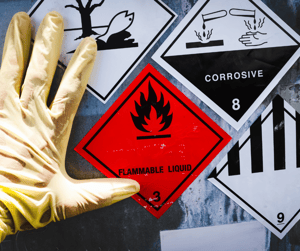If your company currently manufactures products containing PFAS, updated guidance from the EPA may help you better manage this dangerous waste.
The U.S. Environmental Protection Agency has released an updated “Interim Guidance on the Destruction and Disposal of Perfluoroalkyl and Polyfluoroalkyl Substances and Materials Containing Perfluoroalkyl and Polyfluoroalkyl Substances.” This guidance reflects the latest information available to managers who must manage PFAS wastes, including destruction, disposal and storage guidelines.
Here’s what you need to know about managing waste from PFAS and PFAS-containing materials and what the new guidance says so that you can ensure your company remains compliant.
What Are PFAS Chemicals?
PFAS are known as forever chemicals because of their persistent nature. They have been widely used in industry because they are extremely durable. This is due to their makeup of carbon and fluorine atoms that are bonded together, which creates a strong structure that resists degrading over time.
because they are extremely durable. This is due to their makeup of carbon and fluorine atoms that are bonded together, which creates a strong structure that resists degrading over time.
For many decades, PFAS were used in aerospace, automotive, construction and electronic manufacturing industries because of their durable qualities. They’re even found in common household and commercial products like cleaning agents, paints, firefighting foams, food packaging and processing equipment, and stain- and water-resistant fabrics and carpets.
While they serve a purpose in manufacturing, there is a darkside to these chemicals. Studies have linked PFAS exposure to several adverse health issues, including developmental effects in children, cancer, harm to the immune system, liver damage and thyroid disorders. They also can pose a threat to ecosystems and have been detected in soil, water and wildlife.
Recognizing these concerns, the EPA has begun drafting politics and laws that could impact how products are manufactured, especially ones that contain PFAS chemicals. Several states have also taken action to ban or reduce the use of these forever chemicals. States like California, Washington and New York have banned the sale of firefighting foam containing PFAS.
The EPA also recently released updated guidance on how PFAS are disposed of in an effort to prevent soil contamination and other adverse environmental impacts.
What’s New With The EPA’s Guidance?
The newest EPA guidance recommends that decision-makers in companies that use PFAS in the manufacturing of their products to prioritize using technologies that have the lowest potential for environmental release, including during destruction or disposal.
The guidance also:
- Emphasizes the need to release data to the public to validate whether this technology can be implemented on a large scale
- Describes new EPA test methods and improved screening tools to keep communities located near disposal facilities safe
- Helps government officials and private industrial companies make informed decisions about how they use disposal technologies
This newest information provided by the EPA piggybacks onto guidance released in 2020 that focused on three existing technologies: underground injection, landfills and thermal treatment. The EPA also addressed that there are several key data gaps and uncertainties that ongoing research is working to address. These areas of research include ways to reduce PFAS in the environment and methods used to detect these chemicals.
What Are The EPA’s Most Recent Key Findings?
The newest EPA guidance on PFAS includes updated information on destruction and disposal technologies. In general, the EPA recommends that any company use destruction or disposal options that have a lower potential for releasing FPAS into the environment.
general, the EPA recommends that any company use destruction or disposal options that have a lower potential for releasing FPAS into the environment.
For example, the EPA advises that Class 1 wells can be used to isolate liquid waste deep below the land surface. This protects underground sources of drinking water from experiencing contamination from PFAS. However, this type of technology may not be available everywhere.
While many companies use hazardous waste disposal to safely dispose of dangerous materials that can harm human health and the environment, recent research shows that landfills release more PFAS to the environment than previous thought, according to the EPA. For this reason, it’s important to work with hazardous waste disposal companies that transport waste to landfills that meet the requirements of using leachate emission protections. These controls help prevent the release of PFAS from leaving the immediate area when PFAS-containing materials break down in the landfill.
The EPA also released information that pointed to thermal treatment as an option to safely dispose of PFAS-containing materials under certain conditions. Research since 2020 has found that thermal treatment units are more effective at destroying PFAS and minimizing the release of the chemicals.
What Else Should You Know About PFAS Disposal?
Legislation addressing PFAS contamination and regulations is ongoing, reflecting the persistent efforts to reduce the environmental and health risks associated with these harmful chemicals.
As part of the PFAS Strategic Roadmap, the most recent interim guidance is evolving. It's crucial for companies to ensure their disposal methods are safe and compliant, and partnering with reputable transportation companies that stay on top of evolving regulations is important.
Your manufacturing facility should also begin preparing for any further changes in the pipeline when it comes to waste disposal requirements. Collaborating with an experienced waste disposal company can help ensure you are complying with current regulations and future laws.
The last thing you want as a company is to scramble at the last minute to secure proper waste disposal solutions for your materials that contain PFAS chemicals as state and federal officials announced updated regulations. Reputable waste disposal companies actively monitor pending legislation and are ready with strategies that help your business react to any new laws.
When looking for waste disposal services, partner with a company experienced in handling the specific type of waste your business generates. While you may handle materials that contain PFAS, you may also have other types of hazardous waste that require specialized disposal.
Disposal companies should have a comprehensive understanding of Treatment, Storage and Disposal Facilities (TSDFs) and the types of waste they accept, whether they are located locally or in other states.
Other services typically provided by hazardous waste disposal companies include:
- Transportation of your waste to appropriate recycling and disposal sites
- Documentation confirming proper waste disposal
- Waste stream identification through profiling and testing
- A walk-through program that is consultative
- Required transport documentation, such as manifests
- On-site storage evaluations
Look for a partner that offers you a free quote. You should always have a clear understanding of what costs and fees are involved in customized waste management services.
By collaborating with a hazardous waste disposal company, your business can better adapt its waste management plan and procedures to evolving laws, ensuring that you remain on the path to success.
Partnering with a hazardous waste disposal firm that has these qualities and offers these services will help to ensure your business adjusts as PFAS waste management strategies change.


Comment